Ultrasound-guided Perineural Dextrose Injection for Treatment of Superior Cluneal Nerve Entrapment: Serial Case Report
Abstract
Background:
Superior cluneal nerve entrapment is a neuropathic condition caused by the inclusion of the superior cluneal nerve that contributes to one of the causes of lower back pain leading to high morbidity. Several therapeutic modalities
are available for superior cluneal nerve entrapment, including medications, physiotherapy, perineural injection, and surgery. Perineural injection with 5% dextrose has become therapeutic alternative in many cases of neuropathy, but its long-term effectiveness is unknown.
Case Presentation:
This study described four patients with superior cluneal nerve entrapment with severe pain intensity treated with ultrasonography guided perineural 5% dextrose injection, resulting in significant clinical improvement during the 6-month evaluation.
Conclusion:
Perineural injection can be considered as long-term therapy in patients with superior cluneal nerve entrapment who have failed other conventional therapies.


